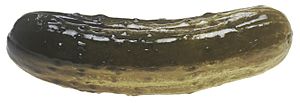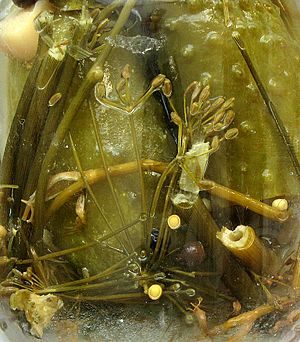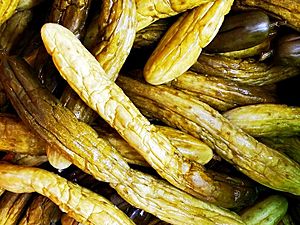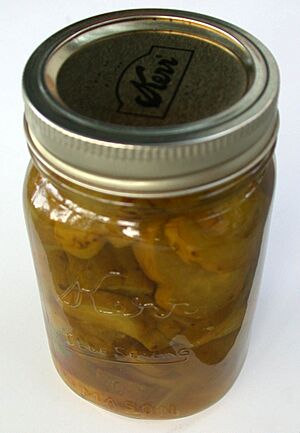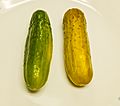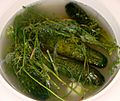Pickled cucumber facts for kids
|
A deli pickle
|
|
| Alternative names | Pickle, gherkin |
|---|---|
| Course | Hors d'oeuvre |
| Main ingredients | Cucumber, brine or vinegar or other solution |
| Variations | Cornichon, gherkin |
A pickled cucumber is a cucumber that has been soaked in a special liquid. This liquid is usually salty water (called brine) or vinegar. The cucumber is left to ferment for a while. This process changes its taste and texture.
In the United States and Canada, people often just call them "pickles." Pickling is a way to preserve many foods, like onions, cabbage, and even fish. One popular type of pickled cucumber is the dill pickle. You can eat pickles by themselves, or add them to foods like hamburgers.
Contents
- What are the different types of pickles?
- Images for kids
- See also
What are the different types of pickles?
- Further information: pickling
Gherkins: Small and Tasty Pickles
A gherkin is a special kind of cucumber. It's usually smaller than the regular cucumbers you might see. Gherkins can be cooked, eaten fresh, or made into pickles.
People usually pick gherkins when they are about 4 to 8 centimeters (1 to 3 inches) long. They are then pickled in jars with vinegar. Often, herbs like dill are added, which is why we have "dill pickles." Sometimes, sugar is added too, making them "Sweet Gherkins."
What are Cornichons?
Cornichons are small, tart (a bit sour) pickles from France. They are made from tiny gherkins pickled in vinegar and tarragon. People often eat them with pâtés or cold cuts.
How are Brined Pickles Made?
Brined pickles are made using a traditional method called natural fermentation. This means they soak in salty water (brine) and become sour over time. The brine can have different amounts of salt, usually between 20 to 40 grams of salt per liter of water. No vinegar is used in the brine for these naturally fermented pickles.
Tiny helpful bacteria called Lactobacillus are naturally found on the skin of cucumbers. These bacteria help the fermentation process. Sometimes, people add other fermented foods like yogurt or sourdough bread to help the process along.
To make them, small cucumbers are put into a glass jar or wooden barrel. Spices like garlic, horseradish, dill stems, mustard seeds, and bay laurel leaves are added. Then, the container is filled with cooled, boiled water and salt. It's left for several weeks, depending on how sour you want them to be. Stones are often placed on top to keep the cucumbers under the water.
A film of bacteria might form on top, but this is normal and doesn't mean they are spoiled. You can just remove it. Brined pickles don't last as long as vinegar pickles and usually need to be kept in the fridge.
What is a US Kosher Dill Pickle?
A "kosher" dill pickle doesn't always mean it follows Jewish dietary laws. Instead, it describes a style of pickle. This style comes from Jewish pickle makers in New York City. They add lots of garlic and dill to a natural salt brine.
In New York, a "full-sour" kosher dill has fermented completely. A "half-sour" pickle has been in the brine for a shorter time. It's still crisp and bright green. Sometimes, these are called "old" and "new" dills. Dill pickles have been popular in New York City since at least 1899.
Polish and German Pickles
Pickled cucumbers made in the Polish or German style are very popular. They are sour, like the kosher dill, but often have different seasonings. Immigrants brought these pickles to many countries, including the United States.
Traditionally, they were kept in wooden barrels. Now, you usually find them in glass jars. A cucumber pickled for only a few days is called ogórek małosolny in Poland. This means "low-salt cucumber" and it's less sour. This is similar to the "half-sour" kosher dills.
Another Polish pickle is ogórek konserwowy. This one is sweeter and more vinegary because of the different preserving liquid used.
In Germany, pickles have a fun Christmas tradition. A pickle ornament is hidden on the Christmas tree. The first child to find it gets an extra gift!
Hungarian Leavened Pickles
In Hungary, people make regular vinegar pickles most of the year. But in summer, they make kovászos uborka, or "leavened pickles," without vinegar. Cucumbers are put in a glass jar with spices (like dill and garlic), water, and salt. A slice or two of bread is added to the top and bottom. The jar is left in the sun for a few days. The yeast in the bread helps the pickles ferment.
Korean Salted Cucumbers
In Korea, oi-ji (오이지) is a type of jjanji, which means salted vegetables.
Lime Pickles for Crispness
Lime pickles are soaked in pickling lime. This is not the citrus fruit! The lime is used to make the pickles extra crisp, not as a preservative. After soaking, the lime is rinsed off. Then, vinegar, sugar, and pickling spices are often added.
Bread and Butter Pickles
Bread-and-butter pickles are sweet and sour. They are made from sliced cucumbers in a mix of vinegar, sugar, and spices. You can find them canned or chilled in the fridge.
The name comes from Omar and Cora Fanning, who were cucumber farmers in Illinois in the 1920s. They sold these pickles and even trademarked the name "Fanning's Bread and Butter Pickles." The story says they traded their extra small cucumbers (made into these pickles) with their grocer for basic foods like bread and butter during tough times.
Cinnamon Pickles
Bright red, cinnamon-flavored pickles are sometimes a special treat around Christmas. They look and feel a bit like canned red cinnamon apple rings.
Swedish and Danish Pickles
Swedish pickled cucumbers, called pressgurka, are thinly sliced. They are mixed with salt and pressed to remove some water. Then, they are put in a jar with a sweet and sour liquid made of vinegar, sugar, dill, and mustard seeds.
Danish cucumber salad, agurkesalat, is similar. But the cucumbers are not pressed, and the liquid doesn't have parsley. This salad often goes with meat dishes, especially roasted chicken, and is used on Danish hot dogs.
There are also "long time pickles" that need months of cool storage before they are ready to eat. In southern Sweden and Denmark, these are made with water, mild vinegar, sugar, dill plants (called krondill), and a little salt. This is known as "Ättiksgurka" and has a crispy sweet and sour taste. Further north in Sweden, more salt is used instead of some vinegar and all the sugar. This is called "saltgurka." Both "ättiksgurka" and "saltgurka" are used in small amounts in certain dishes.
Kool-Aid Pickles
Kool-Aid pickles, also called "koolickles," are popular with children in parts of the Southern United States. They are made by soaking dill pickles in a mixture of Kool-Aid drink mix and pickle brine.
Images for kids
-
Fresh pickling cucumbers for sale in Kraków
-
German pickles called Spreewald gherkins
-
Large gherkins and pickled onions in a fish and chip shop in London
See also
 In Spanish: Pepinillo para niños
In Spanish: Pepinillo para niños


